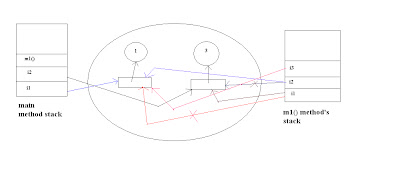SCJP 6 Questions: Pass by reference with example

See the code: class GFC304 { static void m1(int[] i1, int[] i2) { int[] i3 = i1; i1 = i2; i2 = i3; } public static void main (String[] args) { int[] i1 = {1}, i2 = {3}; m1(i1, i2); System.out.print(i1[0] + "," + i2[0]); }} What will be the output? Answer: 1,3 Explanation: Here we are passing the copy of reference variables i1 and i2 from main() method to method m1(). Now m1 has it's own local reference variables i1 and i2 referring to same array as main() method's i1 and i2. So you can see that we are only passing the reference variables not exactly the value they are refering. See this figure... Now see the second code....... class GFC305 { static void m1(int[] i1, int[] i2) { int i = i1[0]; i1[0] = i2[0]; i2[0] = i; } public static void main (String[] args) { int[] i1 = {1}, i2 = {3}; m1(i1, i2); System.out.print(i1[0] + "," + i2[0]); }} What will be the output? Answer: 3,1 Exp
